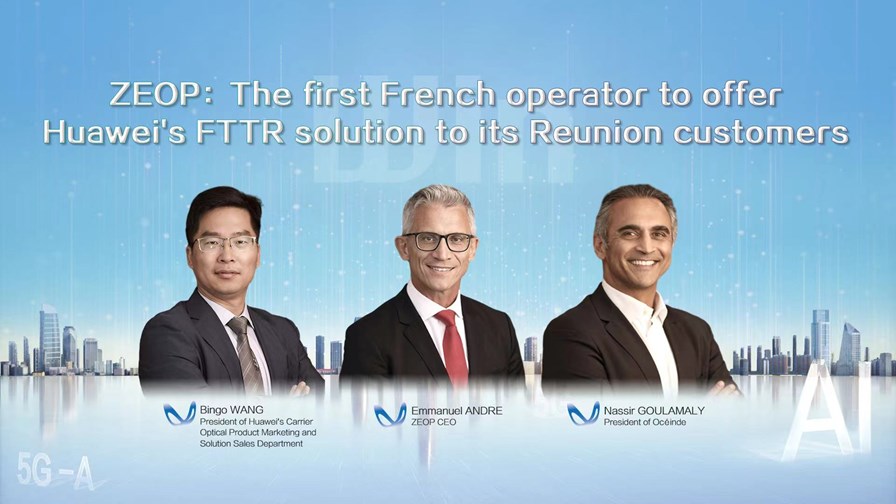
ZEOP, the internet and mobile operator on La Réunion Island, is committed to connecting all La Réunion islanders and offering them a unique experience. For over 10 years, ZEOP has pushed the internet’s boundaries to improve the lives of La Réunion islanders. It is the leader in optical fiber for individuals and a key player in the business market; ZEOP relies on local teams and its own fiber (2011) and 4.5G mobile (2019) networks to deliver the best of digital to the people of La Réunion Island.
In a recent WIN WIN TV telecast, ZEOP CEO Emmanuel Andre was joined by Nassir Goulamaly, president of Océinde (owner of ZEOP), and Bingo Wang, president of Huawei’s carrier optical product marketing and solution sales department.
Last year, ZEOP announced its fiber-to-the-room (FTTR) strategy, and Nassir quickly pointed out this was a huge opportunity to show what his company has achieved. La Réunion Island was the first French department to have fiber-to-the-home (FTTH) ready for all customers. Some 95% of customers already have access to FTTH, and 80% have already bought an FTTH plan. Thirty years ago, ZEOP brought fiber optics from the sea, then to homes 10 years ago by deploying a massive FTTH project. Nassir said a new chapter was opening, allowing customers to go further into homes with FTTR, which is unique and very important for ZEOP customers.
Andre noted that the challenge was to address all customer needs within the house, and with FTTR first talking with the FTTR-ready box and then all the mini boxes, it can deliver the very best experience to its customers.
He also stated that ZEOP decided to carry out a large-scale rollout to make everybody eligible for FTTR. The company decided to change the traditional plan and move to a new plan at the same price but with a box that was FTTR-ready – the first step of the strategy.
From there, ZEOP can deploy the full FTTR installation to customers who will appreciate the technology. The aim is to convert 5%, 10% and maybe 15% of the customer base over the next two years. To cater for those needs, ZEOP has trained a specific team of installers: They start with an exercise that only takes one hour to make the correct diagnosis with the customer, who can decide whether to switch on Wi-Fi in a bedroom or whether to switch it off. Where there is a remote worker and there is a need for 100% bandwidth experience, a decision can be made to keep the maximum spectrum in this room.
After the FTTR is selected, there is a significant impact on the network but a better impact on the customer because they will experience an era of FTTH and FTTR in each room. This will allow them to be ready to do anything they want in all the rooms. The FTTR will be invisible, safe, and very easy to install.
According to Wang the number of global FTTR users had exceeded 14 million. One of the benefits for operators is that FTTR could improve ARPU and reduce churn rate because of the better Wi-Fi performance. ZEOP is also one of the leaders in FTTR service development.
At MWC 2024, Huawei launched the next-generation FTTR product, FTTR F50, which has further improved performance, helping carriers offer more attractive packages like cloud NAS while developing innovative self-bonding fiber to allow consumers a DIY experience. The company believes that FTTR will scale up worldwide.
When asked about Huawei’s deep cooperation with global carriers in FTTR services and what could be learnt from these FTTR pioneers, Wang raised two points. Firstly, face up to the positioning of FTTR services. When the FTTR service was first launched, many people thought it was just targeted at high-end users, such as those living in villas and large flats. In fact, more than 80% of FTTR users of carriers have subscribed to the FTTR 1+1 package. This way, carriers can increase revenue and meet the requirements of subscribers in terms of a high-quality internet access experience.
Secondly, standardising FTTR delivery capabilities is very important. FTTR is not just a new service for users but also a service full of potential for carriers. To support the scaling of FTTR services, the standardised delivery capability is particularly important, such as standard software and tools, same-day delivery and network access, onsite Wi-Fi speed testing and acceptance. These can improve installation and maintenance efficiency, reduce customer complaints and even chargebacks, enhance brand influence, and contribute to sustainable revenue growth.
Related Content: Zeop scales fibre-to-the-room deployments on French island
Email Newsletters
Sign up to receive TelecomTV's top news and videos, plus exclusive subscriber-only content direct to your inbox.




